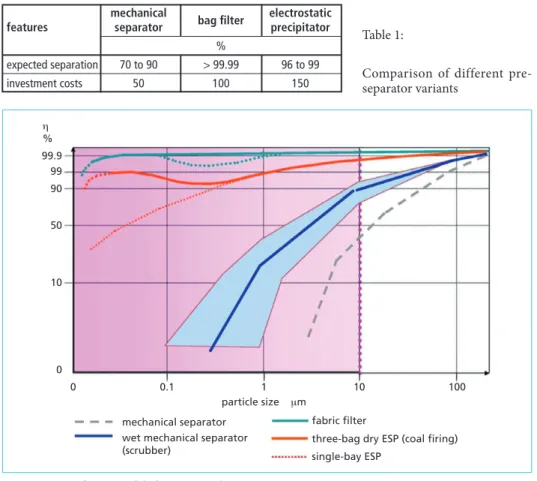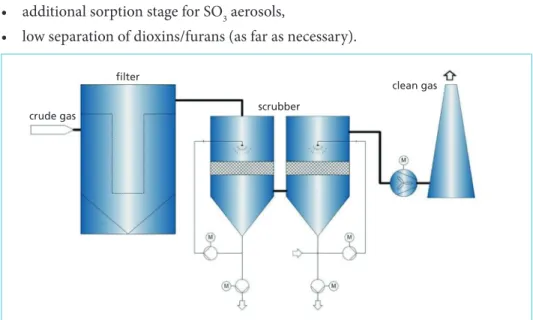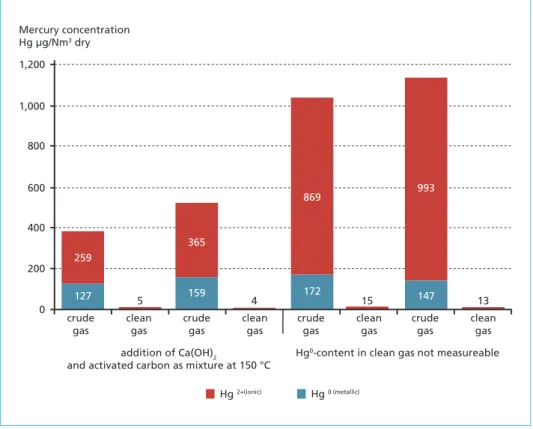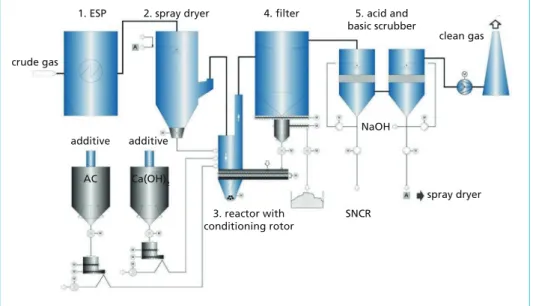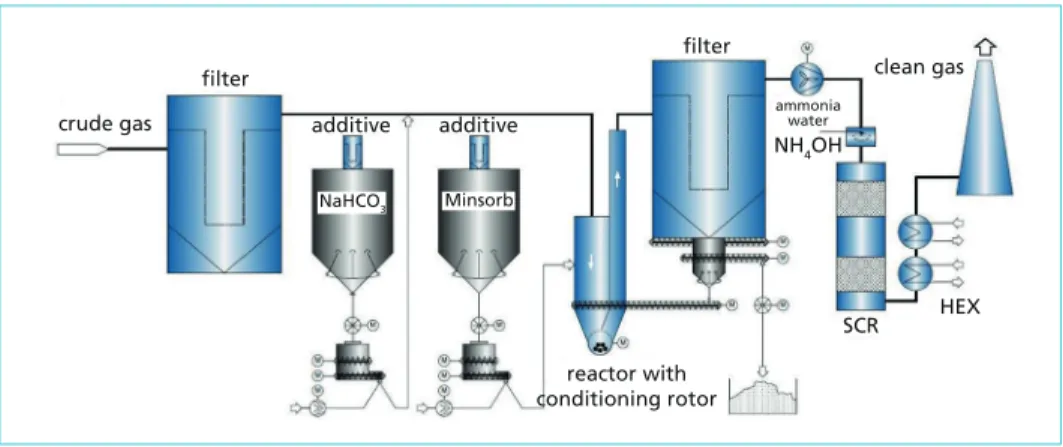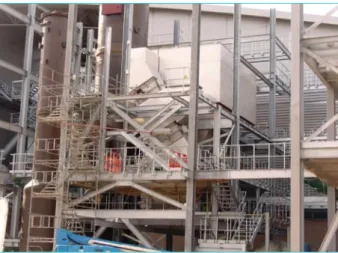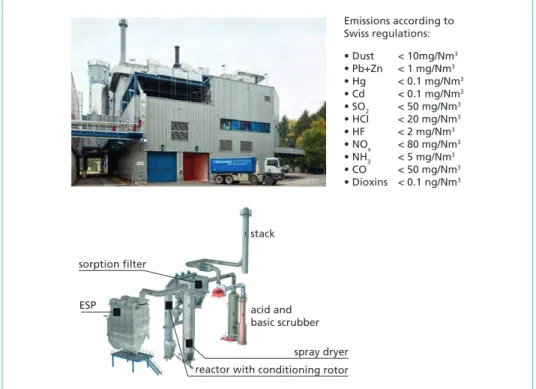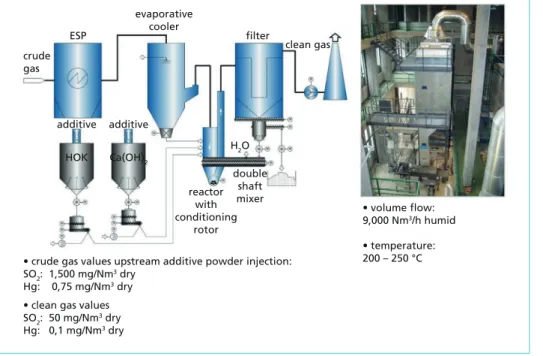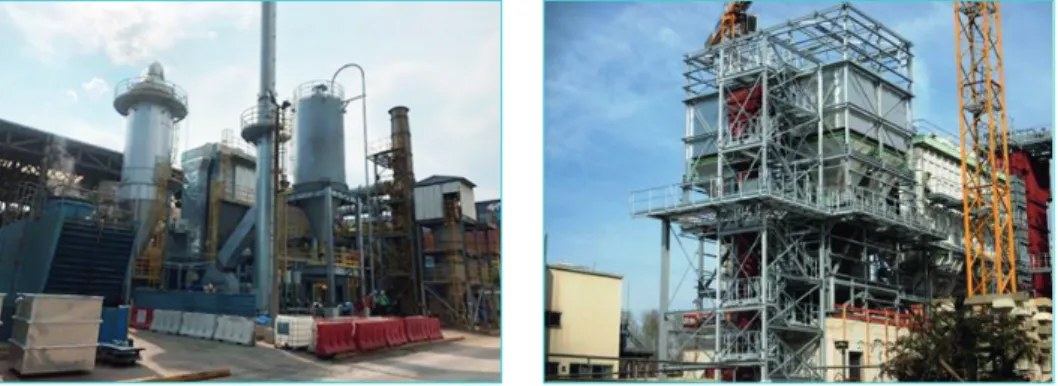LUEHR FILTER GmbH Enzer Straße 26
31655 Stadthagen / Germany
The BREF revision will present challenging emission limit values. However, our experience will help you to find the optimised solution for all different fuels such as Waste, RDF, Biomass or Sewage Sludge.
We guarantee
reliable performance within the specified emission limits
high plant availability at low capital and operating costs
flexible system design modified to the specific application
Phone: +49 5721 708-0 Fax: +49 5721 708-214
E-Mail: project@luehr-filter.com
PARTNER FOR AIR POLLUTION CONTROL
Sewage Sludge
Flue Gas Treatment for Sewage Sludge Incinerators
– Concepts and First Results from Plants in Operation –
Ruediger Margraf
1. Requirements on the gas cleaning ...532
2. Process concepts of gas cleaning ...533
2.1. Separation of fly ash ...533
2.2. Separation of acid crude gas pollutants ...534
2.2.1. Conditioned dry sorption with Ca(OH)2 ...534
2.2.2. Dry sorption with NaHCO3 ...536
2.2.3. Acid and basic scrubber ...537
2.3. Separation of Hg ...538
2.4. NOx reduction and NH3 separation ...540
2.4.1. Combination of SNCR – (conditioned) dry sorption – wet scrubber....540
2.4.2. Integration of an SCR stage ...541
3. Design and plant examples ...542
3.1. SNCR – electrostatic precipitator – 2-stage scrubber with NaOH – dry sorption with Ca(OH)2 / AC ...543
3.2. SNCR – electrostatic precipitator – dry sorption with Ca(OH)2 / AC – 2-stage scrubber with NaOH ...543
3.3. SNCR – cyclone – dry sorption with NaHCO3 / AC – 2-stage scrubber with NaOH ...544
3.4. SNCR – electrostatic precipitator / bag filter – conditioned dry sorption ...545
4. Summary and personal assessment ...546
5. References ...547
The member states of the European Union and on this topic particularly in Germany, the further processing of sewage sludge is currently being discussed, especially with regard to phosphate recycling. Beside the adjustment of the legal conditions regarding the phosphate recycling, additional pressure in Germany raised on the investment of sui- table procedures as a result of the ban on spreading sewage sludge on agricultural land.
Sewage Sludge
Considering for example the sludge quantities in Germany, approximately 1.8 millions of tons of sludge (dry matter) has arisen in 2015 [5]; approximately 1.15 millions of tons hereof are being thermally used and approximately 0.65 millions of tons are being used for agriculture or for landscaping. Suitable recycling methods have to be found for these quantities, considering the phosphate recycling in the future.
The stipulation for the recovery of phosphorus preferably requires a thermal recyc- ling in mono-sludge incineration plants. Based on an additional, annual quantity of 0.4 millions of tons, approximately 15 to 20 mono-sludge incineration plants will be required only in Germany.
While in the course of conceptual design of new plants in the field of incineration a clear trend towards the stationary vortex bed can be observed during selection of a suitable process, the most suited process for the installed gas cleaning system has to be selected with due consideration to the boundary conditions of each project.
1. Requirements on the gas cleaning
Figure 1 shows the separate process stages of a gas cleaning system for mono-sewage sludge incineration plants.
• mechanical separator
• electrostatic precipitator (ESP)
• flat-bag filter
• conditioned dry Ca(OH)2/AC
• dry NaHCO3/AC
• conditioned dry + wet
• wet
• SNCR
• SNCR + acid scrubber for NH3
• SCR fly ash
separation
chemisorption adsorption
NOx reduction NH3 separation
Figure 1: Process stages of a gas cleaning system downstream sewage sludge incineration The stipulation of recycling of phosphorus requires the separation of fly ash as the first process stage of incineration and of flue gas cleaning system installed downstream of boiler. As a result of incineration in a stationary vortex bed, preferred process in mono- sludge incineration plants, the fly ash content in the flue gas is comparatively high with values lying in a range between 50 g/Nm³ humid up to 100 g/Nm³ humid. Independent of the stipulation of phosphorus recycling, this would also require a particle separation in the subsequent process stages of the flue gas cleaning system.
The separation of acid crude gas pollutants, particularly SOx, heavy metals, including mercury plus dioxins/furans, NOx and NH3, if needed, takes place in further process stages.
The selection of the project-related, most suited process concept for the gas cleaning depends among others on the following parameters:
• incineration capacity/plant size,
• exhaust vapour concept (gas humidity, NH3 content in the gas),
Sewage Sludge
• SO2 content in the sewage sludge,
• requested emission limit values,
• residue recycling/transport.
Particularly the chosen concept for the exhaust vapour from the dryer has a considerable influence on the process-related selection of the gas cleaning concept. In the case of minor or limited injection of exhaust vapours from the drying, into the incineration chamber through to a resulting humidity content in the gas of max. 40 % Vol., dry, conditioned dry and even wet processes can be used for the SO2 separation. A process- related max. exhaust vapour injection provided, the resulting humidity content in the gas totals to approximately 50 %Vol. In this case the use of a conditioned dry sorption process is hardly possible. The necessity of a suitable NH3 reduction in the gas cleaning has to be checked in any case.
The NOx reduction usually takes place in the combustion chamber by using an SNCR- process. The NH3 contained in the added exhaust vapours can be used as reduction agent. The use of SCR-technology is necessary only in case of very low emission limit values.
Regarding the above mentioned criteria, the selection of most suited process-related solution has to be based on the boundary conditions of the separate projects.
2. Process concepts of gas cleaning 2.1. Separation of fly ash
Resulting from the stipulation for phosphorus recycling as well as due to the high fly ash content in the flue gas, a fly ash separation with high efficiency will only be pos- sible by means of a bag filter or an electrostatic precipitator. The use of a mechanical separator, e.g. a cyclone, will only be possible in countries without the requirement of phosphorus recycling because of the lower separation efficiency of approximately 70 % to 90 %.
When comparing the bag filter with an electrostatic precipitator, this will result both in technical and commercial advantages for the bag filter. On the one hand the separation efficiency of the bag filter is higher than the one of the electrostatic pre- cipitator (Figure 2). This is advantageous particularly with regard to the recycling of phosphorus. On the other hand, the investment costs for an electrostatic precipitator are clearly higher compared to a flat-bag filter.
With regard to the energy consumption, both types of separators are nearly at the same level. Compared to the electrostatic precipitator the bag filter has a higher pressure loss. In return, the electrostatic precipitator needs more energy for the se- paration of particles at the electrodes and for the electrical trace heating due to the larger external surface.
Sewage Sludge
Figure 2: Efficiency of different particle separators
Source: Schulteß, W.: Presentation material Ingenieurbüro Prof. Wolff Schulteß
2.2. Separation of acid crude gas pollutants
Several processes are available for the separation of acid crude gas pollutants, such as HF, HCl and SO2, which will be described below. The selection of process depends on the basic conditions of the specific plant. Not only the investment and operating costs but also the exhaust vapour concept has to be taken into account with this regard.
It has to be pointed out, that due to the fuel, especially the pollutant SO2 has an impor- tant influence on the design because of the concentrations of approximately 2,000 mg/
Nm³ dry up to > 4,000 mg/Nm³ dry. The values for HCl are comparatively very low and are typically below 100 mg/Nm³ dry.
2.2.1. Conditioned dry sorption with Ca(OH)2
The following order of reaction [2] results for the temperature range of 100 °C and 220 °C typical for fabric filters:
SO3 > HF >> HCl >>> SO2 >>>> CO2
mechanical bag filter electrostatic features separator precipitator
%
expected separation 70 to 90 > 99.99 96 to 99
investment costs 50 100 150
Table 1:
Comparison of different pre- separator variants
99.9 η %
99 90
50
10
0
0 0.1 1 10 100
mechanical separator fabric filter
three-bag dry ESP (coal firing) single-bay ESP
wet mechanical separator (scrubber)
particle size μm
Sewage Sludge
The dry temperature as well as the absolute and relative humidity have a decisive influ- ence on the separation of SO2 and HCl, however, the separation of SO3 and HF does not present any problems within the stated temperature range. To allow a saving of additive powder, it is therefore often reasonable to reduce the gas temperature within reactor to the optimum reaction temperatures. Regarding the SO2 separation this temperature lies in a range between approximately 95 °C up to 110 °C.
However, good additive powder efficiencies, particularly for the separation of SO2 can only be achieved if the water steam partial pressure close to the recycled particulate will at least lie for a short time in the range of the saturated steam pressure. This will be achieved by using the conditioned chemisorption with particle conditioning (Fi- gure 3). Regarding this type of process, the recycled particulate is moistened prior to re-introduction into the reactor. The addition of small quantities of water causes an increase in the water steam content at the surface of the additive powder particles, thus improving the reactivity regarding the acid crude gas components and in this regard particularly regarding SO2.
In the case of high SO2 concentrations of e.g. > 3,000 mg/Nm³, the separation efficiency of the process can be increased by means of a gas re-circulation. An alternative is the injection of CaCO3 into the vortex bed, subject to the SO2 concentration in the gas downstream of the boiler.
crude gas
additive additive
AC
filter
clean gas
H2O
double shaft mixer reactor with conditioning rotor Ca(OH)2
Advantages of process:
• cost-effective additive powder,
• low additive powder consumption, Figure 3: Conditioned dry sorption with Ca(OH)2
Sewage Sludge
• low operating costs,
• simultaneous separation of SO2, Hg as well as PCDD/PCDF.
Disadvantages / Limits of process:
• comparatively complex plant design,
• high investment costs in comparison to a standard dry sorption process,
• the gas humidity should total to < 40 %Vol.,
• no separation of NH3.
2.2.2. Dry sorption with NaHCO3
The dry sorption with NaHCO3 is competing with process technologies using Ca based additive powder qualities [3]. The quite simple process technology of the basic variant is shown in Figure 4. The additive powder is milled and injected into the gas flow upstream of filter. In the case of gas temperatures > 140 °C, a thermal activation of sodium hyd- rogen carbonate will take place which becomes quicker with rising temperatures. This results in the formation of a highly-reactive sodium carbonate. The reaction time from the point of injection of additive powder into the ducting until separation at the filter fabric should total to minimum of 2 seconds. The multiple re-circulation of the particles separated in the filter into the flue gas flow upstream of the filter is advantageous with regard to the separation efficiency and the stoichiometric factor.
The requested limit values can basically be observed with this process, however, com- pared to Ca-based processes, with higher costs for the provision of additive powder qualities. Due to the reason above, this process is mainly used for smaller incineration plants. Even for this process a gas re-circulation or the injection of CaCO3 in the vortex bed will be reasonable in case of high SO2 contents.
Advantages of process:
• simple plant design,
• comparatively low investment costs,
• low stoichiometric factor,
• moderate residue quantities.
Disadvantages / Limits of process:
• expensive additive powder,
• comparably high consumption rates in spite of lower stoichiometric factor,
• high operating costs (possibly reduction due to CaCO3 in the vortex bed),
• no separation of NH3,
• use of high-quality activated carbon/activated coke.
Sewage Sludge Figure 4: Dry sorption with NaHCO3
2.2.3. Acid and basic scrubber Depending on the addition of exhaust vapours into the incineration chamber, the humidity in the gas downstream of the boiler amounts to values between 30 and 50 %Vol. Starting from a humidity of approximately 40 % Vol., the corrosion hazard for dry and conditioned dry processes will be increased considerably. In this case wet flue gas cleaning is the preferred solution.
NaOH is often used as the additive powder type for the separation of SO2 in the ba- sic scrubber. Due to the recently increased procurement costs for NaOH, the use of Ca-based additive powder qualities like CaCO3 are currently being discussed. The low procurement costs for these additive powder qualities, however, are off-set by clearly more complex materials handling, which incurs a higher maintenance requi- rement.
The general disadvantage of this variant is the necessary water processing. Alterna- tively an operation of a scrubber free of waste water will be possible in combination with a spray dryer and a dry or conditioned dry stage. However, the humidity in the gas may in this case not exceed a value of max. 40% Vol.
The additional installation of a dry sorption stage upstream or also downstream of the scrubber may be necessary for the separation of SO3 aerosols which cannot be separated in the wet stage. Typically Ca(OH)2 and activated carbon are chosen as additive powder qualities in the sorption stage.
filter
clean gas
reactor with conditioning rotor
NaHCO3 AC
crude gas additive
additive
Sewage Sludge
Advantages of process:
• very low stoichiometric factor,
• high separation efficiency for SO2,
• if required, separation of NH3 in the acid scrubber.
Disadvantages / Limits of process:
• waste water processing necessary,
• high investment costs,
• saturated water steam plume at stack exit,
• additional sorption stage for SO3 aerosols,
• low separation of dioxins/furans (as far as necessary).
crude gas
filter
scrubber
clean gas
Figure 5: Combination of product filter with acid and basic scrubber
2.3. Separation of Hg
Hg can be present in the gas in different forms and/or different compounds – as ele- mentary mercury (Hg0) or in ionic form (Hg2+) [2]. If the gas contains mercury in ionic form, a separation with the use of activated carbon/activated coke with an acceptable adsorbent load would be possible. In this respect the injection quantity does not only depend on the crude gas concentration but also on the requested clean gas values.
To achieve an efficient separation of Hg0 with at the same time acceptable adsorbent consumption, a conversion of Hg0 into Hg2+ has to take place prior to the adsorption of mercury in the adsorbent agent. Two different types of realisation are possible.
• Self-doping by means of acid components in the gas. Activated carbon + SO2 +
½ O2 → SO3 / H2SO4 adsorbed at activated carbon. SO3 at activated carbon + Hg0 +
½ O2 → HgSO4 in H2SO4 adsorbed at activated carbon.
Sewage Sludge
• External doping of adsorbent prior to injection into the gas flow. In this connection mainly sulphur-doped or brominated adsorbent agents will be used.
When using NaHCO3 and temperatures of approximately 180 °C to 190 °C, brominated activated carbon should be used as a precaution. In the case of a wet flue gas cleaning system, a corresponding additive powder, e.g. NETfloc SMF (Hg0 → HgS), should be used as well.
The graph shown in Figure 6 presents different Hg crude gas- and clean gas values measured in mono-sludge incineration plants. The measurement series have been taken approximately in 1992. Today’s Hg crude gas values found in mono-sludge incineration plants are lying below the illustrated values. This is due to the measures subsequently taken for the reduction of Hg emissions into the environment and in the waste circulation. With regard to the two series of measurements on the right, the Hg crude gas value had been increased on purpose to allow an evaluation of the separation efficiency in case of high Hg values.
Figure 6: Hg measured values in the crude gas and clean gas of sludge incineration plants It may be stated that additionally the separation of dioxins/furans will reliably be pos- sible as a result of the injection of activated carbon/activated coke in case of dry and conditioned dry processes.
1,200
1,000
800
600
400
200
Mercury concentration Hg µg/Nm3 dry
crude gas
addition of Ca(OH)2
and activated carbon as mixture at 150 °C clean
gas
crude gas
clean gas
crude gas
clean gas
crude gas
clean gas
13 15
4 5
Hg 2+(ionic) Hg 0 (metallic)
0 259
365
869 993
172 147
127 159
Hg0-content in clean gas not measureable
Sewage Sludge
2.4. NO
xreduction and NH
3separation
The required measures for NOx reduction and NH3 separation are subject to several factors. Particular factors in this respect are the fuel composition, the incineration concept and the requested clean gas values.
Dependent on the fuel, a stationary vortex bed is currently able to achieve NOx values clearly below 100 mg/Nm³. If due to the boundary conditions of plant further measures will be requested for the NOx reduction, several processes are available. With regard to the investment costs, the SNCR process constitutes the most cost-effective option in comparison with the SCR process. The minimum achievable NOx content for the SNCR process depends on the incineration process in connection with primary measures for the avoidance of a formation of NOx.
As far as extremely low NOx emission limit values have to be observed, the installation of an SCR process might become necessary.
2.4.1. Combination of SNCR – (conditioned) dry sorption – wet scrubber
This process combination [3] especially represents an alternative if the requested NOx emission limit values can reliably be kept by means of an SNCR-process, however with a higher NH3 emission. The basic design of this combined process is shown in Figure 7.
crude gas
1. ESP 2. spray dryer 4. filter 5. acid and basic scrubber
additive additive
clean gas
3. reactor with
conditioning rotor SNCR NaOH
spray dryer AC Ca(OH)2
Figure 7: Combination SNCR – conditioned dry sorption – wet scrubber
The sorption stage installed upstream of scrubber is preferably realised as conditioned dry process. As a result of the good SO2 separation efficiency of this process, the scrubber installed downstream can be utilised as a fine cleaning stage. Subject to the application in question, this stage is used for:
Sewage Sludge
• the separation of NH3 in an acid scrubber,
• the further reduction of emission values e.g. for the acid crude gas components.
Due to the fact that the acid scrubber only serves as a fine cleaning stage for the re- duction of HCl beside the separation of NH3, the waste water quantity can be kept at a low level. Therefore it will be appropriate to add this waste water near the incineration.
To allow an operation totally free from waste water, the waste water from the basic stage should be injected into the system near the conditioned dry sorption. The spray dryer upstream conditioned dry stage is not needed any more in most cases. It may be remarked in addition that the stoichiometric factor for Ca(OH)2 can be reduced due to the scrubber installed downstream.
Advantages of process:
• high separation efficiency
• NH3 separation in the acid stage of scrubber
• low stoichiometric factor
• no water processing necessary Disadvantages / Limits of process:
• complex process
• high investment costs
• saturated water steam plume at stack
2.4.2. Integration of an SCR stage The necessity of the installation of a catalyst for the NOx reduction combined with low NH3 slippage flow, will only be used in special cases for mono-sewage sludge incine- rations. The following two concepts are presented in brief for a variety of process variants.
Combination SCR – dry sorption In the case of a combination with a bag filter the preferred temperature range for the catalyst [3] lies in a range of 220 °C up to 240 °C. This temperature range allows a sufficiently good transformation speed. Problems due to the formation of ammonium sulphate can reliably be excluded, as far as the temperature-dependent SO2 content in the gas is < 10 to 25 mg/Nm³. At the same time, this temperature range is particularly suited to dry sorption with NaHCO3.
Due to the chosen temperature range above 180 °C, the use of AC or HOK will not be possible. When using Minsorb or clay minerals, the reduced separation efficiency, particularly with regard to Hg, has to be taken into account.
Sewage Sludge
Figure 8: Combination SCR – dry flue gas cleaning Combination SCR – conditioned dry sorption
In the case of this process combination, a heat exchanger has to be installed downstream of the product filter. This will be necessary to ensure an adequate temperature for the catalyst following the conditioned dry flue gas cleaning. Resulting from the temperature difference of approximately 30 K, it will be necessary to increase the flue gas take-over temperature to approximately 240 °C. The installed SCR process is in this case operated with a temperature of approximately 210 °C. The formation of ammonium sulphate can be excluded in this temperature range as far as the temperature-dependent SO2 content in the gas is < 8 mg/Nm³. Figure 9 shows the basic scheme of a corresponding process.
crude gas filter
filter
additive additive
clean gas
reactor with conditioning rotor
SCR HEX
NH4OH
ammonia water
NaHCO3 Minsorb
crude gas filter
filter
clean gas
reactor with conditioning rotor heat
exchanger
H2O
SCR NH4OH
ammonia water
Figure 9: Combination SCR – conditioned dry flue gas cleaning
3. Design and plant examples
In the following some installed concepts and/or concepts in process of installation are presented in brief. It should be noted that only a limited selection of concepts can be listed in this connection.
Sewage Sludge
3.1. SNCR – electrostatic precipitator – 2-stage scrubber with NaOH – dry sorption with Ca(OH)
2/ AC
To this day this process configuration was a very frequently chosen concept for the gas cleaning of sewage sludge incineration plants. The scrubber takes over the essential separation of the acid crude gases and of NH3. The downstream installed dry sorption serves for the separation of SO3, Hg, PCDD/PCDF as well as of heavy metals. This concept requires the installation of a water processing system as well as the reheating of gases downstream of the scrubber. The advantage of this process variant is the reliable achievement of the requested limit values.
Figure 10 shows the assembly of the dry sorption system downstream of a scrubber supplied within the scope of a project in Great Britain.
3.2. SNCR – electrostatic precipitator – dry sorption with Ca(OH)
2/ AC – 2-stage scrubber with NaOH
The mono-sewage sludge incineration plant in Zurich may be named as an example for this process configuration. [1] To allow the achievement of the low NOx limit value of
< 80 mg/Nm³ dry, the integration of an SNCR-process with ammonia water injection directly into the combustion chamber is used. This may cause increased ammonia emissions. The simultaneous and reliable observance of the stringent Swiss NH3 limit value of < 5 mg/Nm³ dry will be ensured with a wet scrubber.
Plant parameters:
• Commissioning: 2016
• Partially dehydrated sludge: 100,000 t/a
• Dry matter: 30,000 tDM/a
• Volume flow: 26,500 Nm3/h humid Figure 10:
Gas cleaning with scrubber and dry sorption during assembly
Sewage Sludge
Emissions according to Swiss regulations:
• Dust < 10mg/Nm3
• Pb+Zn < 1 mg/Nm3
• Hg < 0.1 mg/Nm3
• Cd < 0.1 mg/Nm3
• SO2 < 50 mg/Nm3
• HCI < 20 mg/Nm3
• HF < 2 mg/Nm3
• NOx < 80 mg/Nm3
• NH3 < 5 mg/Nm3
• CO < 50 mg/Nm3
• Dioxins < 0.1 ng/Nm3
stack
ESP acid and
basic scrubber sorption filter
spray dryer reactor with conditioning rotor
3.3. SNCR – cyclone –
dry sorption with NaHCO
3/ AC – 2-stage scrubber with NaOH
This process configuration has been installed for a small sewage sludge incineration plant in Switzerland. Figure 12 shows the plant.
Figure 12: Sludge incineration SVA Posieux Figure 11: Sewage sludge incineration Zurich
Sewage Sludge
Plant parameters:
• Commissioning: 2018
• Partially dehydrated sludge: 56,000 t/a
• Dry matter: 16,800 tDM/a
• Volume flow: 15,000 Nm3/h humid
Considering the low throughput rate as well as the technical and economic aspects, a concept with a mechanical pre-separator and a dry flue gas cleaning stage with the injection of NaHCO3 as the additive powder had been chosen for this project. The wet stage already existing prior to the modification is serving as a fine cleaning stage.
Measurements taken in the gas downstream of the dry sorption stage showed that SO2 values < 50 mg/Nm³ can be kept reliably in the case of crude gas values of approximate- ly 2,000 mg/Nm³. The stoichiometric factor in this connection is < 1.2. The excellent additive powder utilisation is due to the multiple particle re-circulation.
3.4. SNCR – electrostatic precipitator / bag filter – conditioned dry sorption
A first plant applying this process configuration has already been installed for the sewage sludge incineration plant in Lugano in 2001 (Figure 13). However, after some years with successful operation, this plant had been shut down because an alternative method of recycling had been found for the sludge. During operating time it could be proven that the required SO2 clean gas value of < 50 mg/Nm³ could be maintained with a stoichiometric factor clearly less than twofold.
Figure 13: Sewage sludge incineration Lugano
crude gas
• crude gas values upstream additive powder injection:
SO2: 1,500 mg/Nm3 dry Hg: 0,75 mg/Nm3 dry
• clean gas values SO2: 50 mg/Nm3 dry Hg: 0,1 mg/Nm3 dry
• volume flow:
9,000 Nm3/h humid
• temperature:
200 – 250 °C filter
ESP
evaporative cooler
clean gas
reactor with conditioning
rotor H2O
double shaft mixer additive additive
HOK Ca(OH)2
Sewage Sludge
This concept has also been preferred for two further projects currently in the process of installation in Germany and another project in Singapore, due to the advantageous overall costs (investment and operating costs). Figure 14 shows two of these plants.
Even for further projects in the process of being designed, this variant shall be used.
Figure 14: Sewage sludge incineration ECO Singapore (left) and TVM Mainz (right)
System data of plant TVM Mainz:
• Commissioning: 2019
• Partially dehydrated sludge: 152,360 t/a
• Dry matter: 37,500 tDM/a
• Volume flow: 29,500 Nm³/h humid
4. Summary and personal assessment
Reliable process solutions are available for the safe observance of emission limit values.
The concept of the gas cleaning has to be optimised and determined for each plant on the basis of specific boundary conditions and requirements. In this connection parti- cularly the site location, the plant size, the crude gas values and the emission limits, as well as the exhaust vapour concept have to be taken into account.
At present several new plants for sewage sludge incineration are being designed in Germany. However, a clear trend towards a specific process cannot be observed. Besi- des the conditioned dry sorption other concepts with the utilisation of a wet cleaning stage are still being discussed. In this connection the scrubber is often serving as a fine cleaning stage installed downstream of the conditioned dry sorption. For almost all currently discussed process options, an operation free from waste water is obligatory.
A most suitable concept will not be available in future. The process most appropriate for the specific conditions has to be chosen out of the variety of possible options available.
Sewage Sludge
5. References
[1] Decker, R.; Müller, D.: Successful Execution and Commissioning of Sludge Incineration Plants, 4th International VDI Conference – Energy and Materials from Waste 2017 in Copenhagen [2] Margraf, R.:Process variants of dry and semi-dry / conditioned dry sorption, illustrated by means
of practical examples, VDI Wissensforum 2016
[3] Margraf, R.: Influence of New WI-BREF on the Concepts of Flue Gas Cleaning in the Future – What Will Change? In: Thiel, S.; Thomé-Kozmiensky, E.; Winter, F.; Juchelková, D. (Eds.): Was- te Management, Volume 8, Waste-to-Energy. Neuruppin: Thomé-Kozmiensky Verlag GmbH, 2018, pp. 541-557
[4] Schulteß, W.: Presentation material Ingenieurbüro Prof. Wolff Schulteß
[5] Regulation concerning the recycling of sewage sludge, sewage sludge mixtures and sewage sludge compost (sewage sludge regulation – AbfKlärV), 27.09.2017
Contact Person
Dipl.-Ing. Ruediger Margraf LUEHR FILTER GmbH Managing Director Enzer Straße 26 31655 Stadthagen GERMANY +49 5721708-200
r.margraf@luehr-filter.com
Bibliografische Information der Deutschen Nationalbibliothek Die Deutsche Nationalbibliothek verzeichnet diese Publikation in der Deutschen Nationalbibliografie; detaillierte bibliografische Daten sind im Internet über http://dnb.dnb.de abrufbar
Thiel, S.; Thomé-Kozmiensky, E.; Winter, F.; Juchelková, D. (Eds.):
Waste Management, Volume 9 – Waste-to-Energy –
ISBN 978-3-944310-48-0 Thomé-Kozmiensky Verlag GmbH
Copyright: Elisabeth Thomé-Kozmiensky, M.Sc., Dr.-Ing. Stephanie Thiel All rights reserved
Publisher: Thomé-Kozmiensky Verlag GmbH • Neuruppin 2019 Editorial office: Dr.-Ing. Stephanie Thiel, Elisabeth Thomé-Kozmiensky, M.Sc.
Layout: Claudia Naumann-Deppe, Janin Burbott-Seidel, Sarah Pietsch, Ginette Teske, Roland Richter, Cordula Müller, Gabi Spiegel Printing: Universal Medien GmbH, Munich
This work is protected by copyright. The rights founded by this, particularly those of translation, reprinting, lecturing, extraction of illustrations and tables, broadcasting, micro- filming or reproduction by other means and storing in a retrieval system, remain reserved, even for exploitation only of excerpts. Reproduction of this work or of part of this work, also in individual cases, is only permissible within the limits of the legal provisions of the copyright law of the Federal Republic of Germany from 9 September 1965 in the currently valid revision. There is a fundamental duty to pay for this. Infringements are subject to the penal provisions of the copyright law.
The repeating of commonly used names, trade names, goods descriptions etc. in this work does not permit, even without specific mention, the assumption that such names are to be considered free under the terms of the law concerning goods descriptions and trade mark protection and can thus be used by anyone.
Should reference be made in this work, directly or indirectly, to laws, regulations or guide- lines, e.g. DIN, VDI, VDE, VGB, or these are quoted from, then the publisher cannot ac- cept any guarantee for correctness, completeness or currency. It is recommended to refer to the complete regulations or guidelines in their currently valid versions if required for ones own work.

